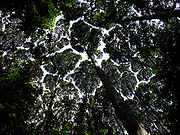
Forest Research Institute Malaysia
Encyclopedia


Government agency
A government or state agency is a permanent or semi-permanent organization in the machinery of government that is responsible for the oversight and administration of specific functions, such as an intelligence agency. There is a notable variety of agency types...
of the Government of Malaysia, under the Ministry of Natural Resources and Environment. FRIM promotes sustainable management and optimal use of forest
Forestry
Forestry is the interdisciplinary profession embracing the science, art, and craft of creating, managing, using, and conserving forests and associated resources in a sustainable manner to meet desired goals, needs, and values for human benefit. Forestry is practiced in plantations and natural stands...
resources in Malaysia by generating knowledge and technology through research, development and application in tropical forestry. FRIM is located in Kepong
Kepong
Kepong is a major township in the borders Kuala Lumpur and Selangor, located about 6 km from the KLCC, to the south of Sungai Buloh, to the east of Bukit Lanjan, to the west of Selayang and to the north of Jalan Duta. The main access roads to Kepong are Damansara-Puchong Expressway, Jalan...
, near Kuala Lumpur.
Historic moments - Built, War and The Establishment
At the time when the country's lowlands were still covered by large tracts of virgin forest, and the forest of the hill and montane areas were pristine, the selected a denuded landscape for their project.In 1926, the Chief Conservator of Forest (equivalent to today's Director of Forestry), G.E.S Cubitt, asked Dr. F.W. Foxworthy to established a separate forest research unit for the Forestry Department. It was Foxworthy who selected the present site, at Kepong. He was also to become the Institutes's first Chief Research Officer.
The site comprised an area that was practically stripped of its original forest cover except for a few remnant trees at the more inaccessible localities. Lalang-grass scrub on the hillsides made way to vegetable terraces on the lower slopes, while the valley cradled a few ponds, the left-overs of a past tin-mining operation.
Within two years in 1928, the first 42 hectares of experimental plantation (mainly Dipterocarps, tall hardwood species) were in place, carefully nurtured into being using "nurse" trees of other species as shade and food providers (being nitrogen -fixers). By the time the construction of the main building had begun. Completed the following years, this building was to remain the sole centre for the laboratories, Herbarium, and Museum, as well as the Chemistry, Zoology and Sivilculture sections of the Institute, until new buildings were added after World War II. The Herbarium collection that was also moved to Kepong, numbered a modest 1,500 accessions.
The end of the decade saw some 125 hectares of plantation established at the Institute. Plantation trials with exotic species started in the early 1930's. The plantations covered 154 hectares just before the outbreak of World War II in Europe in 1939, and before the Japanese Occupation of the Malay Peninsula
Malay Peninsula
The Malay Peninsula or Thai-Malay Peninsula is a peninsula in Southeast Asia. The land mass runs approximately north-south and, at its terminus, is the southern-most point of the Asian mainland...
in 1941–1945. By this time the Dipterocarp and non-Dipterocarp arboreta contained 75 species (represented by 360 individual trees), while the Herbarium collection numbered nearly 40,000 accessions.
The Establishment
Six years later, Encik Abdul Rahman Mohd. Ali was appointed the Institute's first Malaysian Director and Chief Research Officer. The ground of the Institute expanded by a further 192 hectares in 1962 and 1964 to total 600 hectares.
In 1977 Dr. Salleh Mohd. Nor was appointed to his present post of Director General of the Institute. Eight years later, the Institute was transformed into a statutory body. Through an Act of Parliament, the Malaysia Forestry Research and Development Board (MFRDB) was formed to administer the Institute, which was now named FOREST RESEARCH INSTITUTE of MALAYSIA (FRIM). This historic change was announced by the EX-Prime Minister Tun Dr Mahathir Bin Muhammad when he visited FRIM on June 11, 1984. The formal inauguration of FRIM took place later, on April 5, 1986.
Objectives
- 1. Generating scientific knowledge for the understanding, management, conservation and use of forest resources;
- 2. Achieving excellence in research and development through the use of the latest scientific equipment;
- 3. Studying biodiversity to produce useful products through intensive research and development;
- 4. Developing related technology to fulfil the needs of the forestry industry;
- 5. Packaging research and development findings for dissemination to clients;
- 6. Commercializing research and development findings through technology transfer to all interested parties;
- 7. Providing excellent service to fulfil client needs;
- 8. Creating strategic cooperation with local and international agencies;
- 9. Raising public awareness regarding the importance of the environment and the conservation of forest biodiversity.

